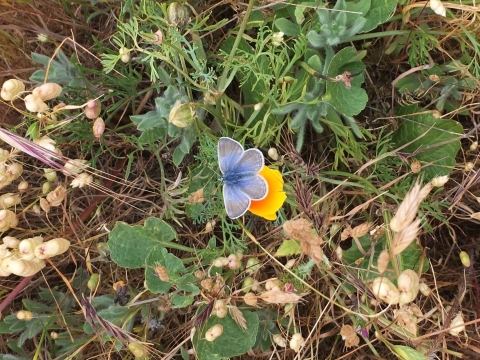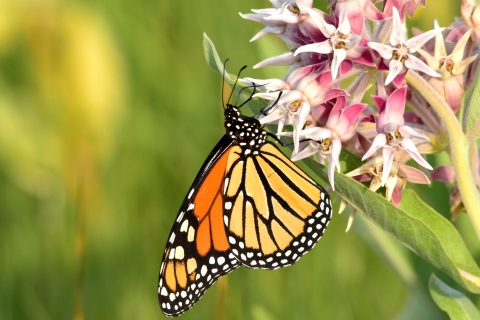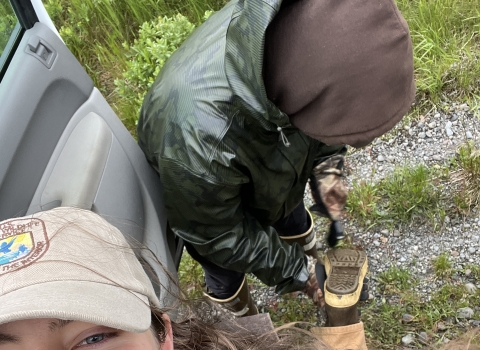Life is hectic. Did you know that creating art can help relieve stress? No matter the age, coloring has been shown to reduce anxiety and improve focus.
Lucky for you, we created four color-by-number drawings to provide you with a well-earned mental break and an opportunity to learn about beautiful pollinators in California.
Pollinators are important players in our ecosystem. They transfer pollen from flower to flower, fertilizing plants and bringing about the next generation of seeds. While not every plant species requires pollinators, there are so many plants that have evolved to have a relationship with a certain species of bee or butterfly. Scientists have even been able to accurately predict the existence of a certain pollinator in an area purely from looking at the structure of a flower! Many butterflies and moths lay their eggs on a single species or genus, known as the larval host plant.
These coloring pages feature five colorful pollinators that live in California. While you’re downloading and printing the pages (print-only documents), check out the fun facts on each species below.
Mission Blue Butterfly
Scientific name: Icaricia icarioides missionensis
Status: Endangered
Host plant: Silver lupine (Lupinus albifrons), summer lupine (L. formosus) and manycolored lupine (L. variicolor).
Where they live: San Francisco Bay Area grasslands in Marin, San Francisco, and San Mateo counties
- Males are bluer overall compared to females, which have more brown on their wings.
- The fuzzy, green caterpillars hatch on their host plant, lupine, and only eat lupine until they’re ready to pupate and become butterflies.
- If you want to catch a glimpse of a mission blue butterfly, visit the Marin Headlands at the Golden Gate National Recreation Area in Marin County, San Bruno Mountain in San Mateo County, or Twin Peaks in San Francisco between March and July and you might see one!
Kern Primrose Sphinx Moth
Scientific name: Euproserpinus euterpe
Status: Threatened
Host plant: Evening primrose family (Onagraceae; Camissonia species)
Where they live: Kern County, San Luis Obispo County, Santa Barbara County and Ventura County, CA
- The adult Kern primrose sphinx moth is brown, but the caterpillar is full of color!
- The moth is in the family Sphingidae, which is the same family as tomato hornworms and hummingbird moths.
- When it’s ready to make its cocoon, it buries itself in the sand. Sometimes, it can even stay there for years waiting for the right conditions to come out as an adult.
- You might see one of these at Carrizo Plain National Monument from late January to late February.
Myrtle’s Silverspot Butterfly
Scientific name: Speyeria zerene myrtleae
Status: Endangered
Host plant: Western dog violet (Viola adunca)
Where they live: Coastal dunes and bluffs from Sonoma County to Marin County, CA.
- Myrtle’s silverspot butterfly gets its name from the white spots on the ventral side of its wings which is the side you see when the wings are closed
- The caterpillars of Myrtle’s silverspot hatch in summer or early fall but then sleep until the next spring when they wake up and feed on western dog violet.
- To spot a Myrtle’s silverspot butterfly, you might have luck at Point Reyes National Seashore between June and August.
Bay Checkerspot Butterfly
Scientific name: Euphydryas editha bayensis
Status: Threatened
Host plant: California plantain (Plantago erecta)
Where they live: Serpentine grasslands of Santa Clara County, CA and annual grasslands at San Bruno Mountain in San Mateo County, CA.
- Bay checkerspot caterpillars go through two different phases of feeding with a pause in between. The first is just after they hatch between March and May, where they will feed until they have molted three times. Then after going dormant for the hot and dry months of summer and fall, they wake up sometime in November to February, and eat more until finally making their chrysalis in early spring.
- The Bay checkerspot butterfly has brilliant markings in a mosaic of white, black, and orange, but don’t get this confused with more common orange butterflies like the painted lady. This butterfly was only found in Santa Clara County until recently reintroduced to San Bruno Mountain and Edgewood County Park in San Mateo County, CA.
Monarch Butterfly
Scientific name: Danaus plexippus
Status: Candidate species for listing
Host plant: Native milkweed (regionally native Asclepias species)
Where they live: Monarchs can be found seasonally throughout the United States, southern Canada and Central America. They can be seen at more northern sites in the summer and southern sites in the winter or year-round.
- Monarchs are famous for their long migrations – more than 3,000 miles! However, most individuals don’t migrate long distances. Monarchs go through four or more generations in the summer, and only the last generation makes the long migration south. There are also many populations of monarchs in warm climates that do not migrate at all.
- Migrating monarchs overwinter in huge colonies, often in trees.
- While adult monarchs usually live 2 to 6 weeks, the migrating generation can live 8 to 9 months!
- You can help support monarchs by planting milkweed species native to your area. Remember, native milkweed species are best for the monarchs. Nonnative varieties, such as tropical milkweed, can spread disease or confuse monarchs due to the plant’s different growing season.













